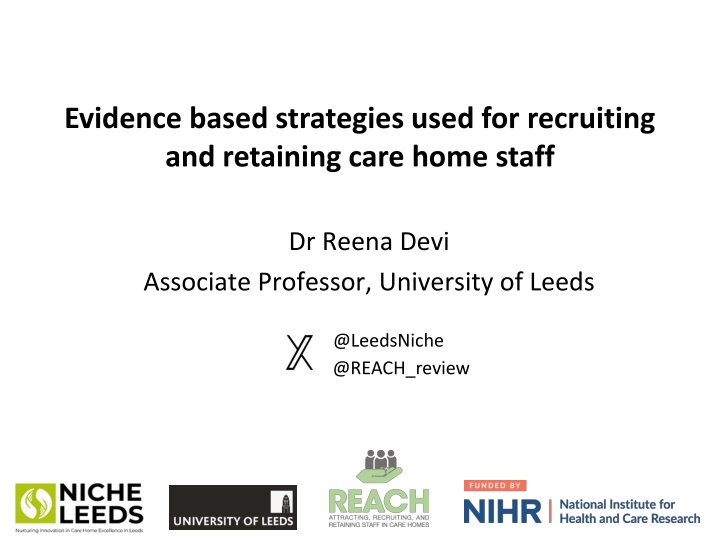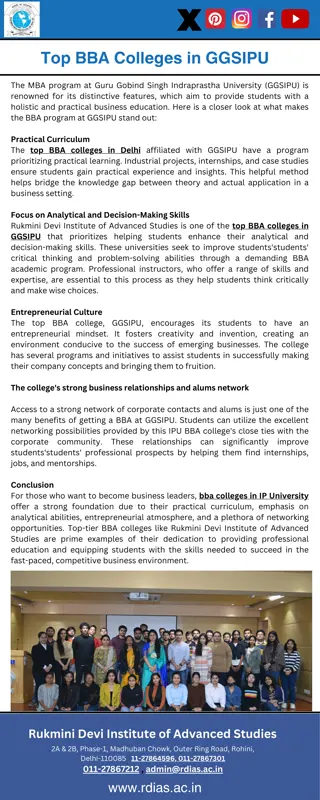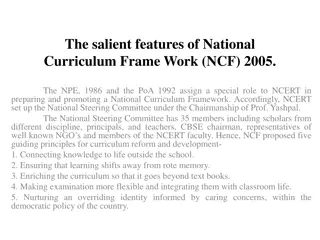
Evidence-Based Strategies for Recruiting and Retaining Care Home Staff
Explore evidence-based strategies utilized by Dr. Reena Devi, Associate Professor at the University of Leeds, to recruit and retain care home staff effectively. Discover how factors like workforce heterogeneity and sector diversity impact staff experiences, and learn about key strategies such as effective interviewing, career development, and promoting work-life balance.
Download Presentation

Please find below an Image/Link to download the presentation.
The content on the website is provided AS IS for your information and personal use only. It may not be sold, licensed, or shared on other websites without obtaining consent from the author. If you encounter any issues during the download, it is possible that the publisher has removed the file from their server.
You are allowed to download the files provided on this website for personal or commercial use, subject to the condition that they are used lawfully. All files are the property of their respective owners.
The content on the website is provided AS IS for your information and personal use only. It may not be sold, licensed, or shared on other websites without obtaining consent from the author.
E N D
Presentation Transcript
Evidence based strategies used for recruiting and retaining care home staff Dr Reena Devi Associate Professor, University of Leeds @LeedsNiche @REACH_review
Developing strategies for sustaining the workforce Developing strategies for sustaining the workforce - - what do we need to consider? what do we need to consider? Multiple factors affect staff experiences Sector heterogeneity Multiple, and tailored solutions are needed Workforce heterogeneity Devi, R., Goodman, C., Dalkin, S., Bate, A., Wright, J., Jones, L. and Spilsbury, K., 2021. Attracting, recruiting and retaining nurses and care workers working in care homes: the need for a nuanced understanding informed by evidence and theory. Age and ageing, 50(1), pp.65-67.
Method Realist synthesis to identify & explain strategies used to recruit, & retain care home staff Step 3: Article selection & analysis Step 4: Bringing evidence together Step 1: Develop initial theories Step 2: Search for evidence Interviews (n=13), consultations (n=10), scoping literature search (n=50) Final list of strategies: 181 papers selected and data extracted. Searched: academic databases (n=8) social care websites (n=17) 1. Effective interviewing 2. Career development 3. Reward & recognition 4. Promoting work-life balance 10 prioritised for testing: Consultations with frontline staff, managers and human resources staff to shape and refine findings. Staff recognition Flexible working Career development Salary package Early investment Induction Continuous feedback Caring community Effective interviewing Listening to all staff 3309 records retrieved 5. Caring conversations
Findings - Framework of strategies used to recruit and retain care home staff Strategies are used in an inclusive and equal way Strategies enabled with supportive leadership Professional and welcoming environment development Career Staff are listened to, respected & valued New recruit understand the role Confidence with choices Effective interviewing Job satisfaction Work-life balance Staff recruitment Staff retention
Findings - Framework of strategies used to recruit and retain care home staff Strategies are used in an inclusive and equal way Strategies enabled with supportive leadership Professional and welcoming environment development Career Staff empowerment Staff are listened to, respected & valued New recruit understand the role Psychological contract developed Psychological contract fulfilled Job Confidence with choices Effective interviewing satisfaction Staff reciprocity Work-life balance Staff recruitment Staff retention
Findings - Framework of strategies used to recruit and retain care home staff Strategies are used in an inclusive and equal way Strategies enabled with supportive leadership Professional and welcoming environment development Career Staff empowerment Staff are listened to, respected & valued New recruit understand the role Psychological contract developed Confidence with choices Effective interviewing Job Psychological contract fulfilled satisfaction Work-life balance Staff reciprocity Costs and resources Costs and resources Access, time and support for career development Recognition for increased responsibilities Funds for financial reward Tune fir building relationships Leadership time and skills for caring conversations Flexible working policies, senior staff time to implement Funds and staff to arrange cover Trained interviewers, time, interview templates, realistic job previews
Conclusions and next steps Multiple, and tailored solutions are needed Evidence needs to be mobilised and embedded into practice We ve unpacked part of the puzzle gaps remain
The REACH study team Judy Wright Natalie King Kirsty Haunch Sonia Dalkin Claire Goodman Liz Jones Karen Spilsbury Angela Bate Reena Devi Vinny Kennedy Karen Winterburn Edna Feenan
Funder The National Institute for Health Research (NIHR Health Services and Delivery Research, NIHR131016) Disclaimer The views expressed in this publication are those of the author(s) and not necessarily those of the NHS, the NIHR or the Department of Health and Social Care. Contact email: R.Devi@Leeds.ac.uk @_DrReenaDevi @LeedsNiche @REACH_review





















